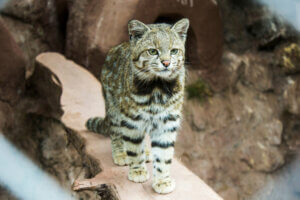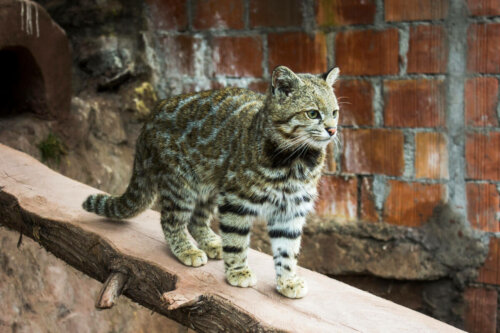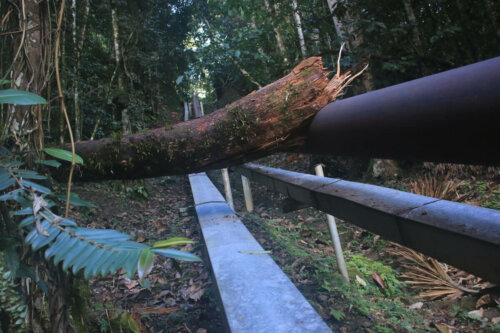The Andean Cat - A Seriously Endangered Feline

The Andean cat (Leopardus jacobita) is a small wild cat endemic to South America. It’s one of the most endangered species of the American continent. Also, one of the least known felids on the planet. Its distribution is mainly in the mountainous regions of the Andes, Peru, and northern Bolivia, Chile, and Argentina.
Considered a sacred animal by many Andean tribes, this species is historically valuable to the local communities there. Various Andean cultures have engraved the animal’s likeness in petroglyphs throughout the ages and they consider them the protective spirits of the mountains. Continue reading to find out more about this beautiful endangered animal.
What is the Andean cat like?
These small animals measure between 29 and 35 inches long and have a long ringed tail of more than 15 inches long. They don’t usually exceed 15 inches in height and weigh between 8 and 16 pounds. In other words, they’re about the size of a domestic cat.
In addition, their coat is long, dense, gray with reddish-yellowish spots evenly arranged on both sides of the body. Their belly is white and their ears big and rounded while their nose is completely black and the paws short and robust.

The habitat of the Andean cat
This wild cat lives in arid, rocky, sparsely vegetated environments and near water sources. You could find them at high altitudes, between 9800 and 16400 feet above sea level where temperatures are extreme and strong gusts of wind blow continuously.
These rocky landscapes aren’t continuous. The habitat of the Andean cat – and its prey – has naturally fragmented. Therefore, human disturbances make it even more difficult to spread them. As you can see, the density of their populations is quite low. In fact, estimates indicate there are about 1400 adult individuals in the wild but the number is decreasing.
In addition, some people believe the Andean cat and the Pampas cat (Leopardus colocolo) share the same territory. The feline that concerns us here is a more specialized species with a narrower range of resources than the Pampas cat. This is because it would lose – in terms of interspecific competition.
There are few sightings of this animal due to its elusive behavior and the difficulty of the terrain they inhabit. Only through advanced techniques, such as the use of photo-trapping cameras and radio collars, has it been possible to calculate the number of wild specimens.
An elusive and unknown animal
The Andean cat is a loner and thus quite difficult to run into. This is why we don’t know much about their life habits. Some believe they’re more active at night and during the first half of the day when it’s probably easier to trap their next meal.
Some people have spotted them in pairs between the months of July and December and with their offspring between October and April. The mother may protect her litter inside burrows made by digging mammals or in cracks between rocks.
Native rodents are the main prey of the Andean cat, such as the yellow-rumped leaf-eared mouse (Phyllotis xanthopygus), the Southern viscacha (Lagidium viscacha), the ashy chinchilla rat (Abracoma cinerea), or the mountain degu (Octodontomys gliroides). Researchers also documented that this cat can also capture birds, insects, and other small mammals.
Threats to the sacred Andean cat
The main threats Andean cats face are poaching, scarcity of prey, and loss of habitat. Unfortunately, this animal is “sacred” to some ethnic groups who sacrifice them in some of their festivals. Thus, these are two of the main threats to the species, along with poaching for their fur.
Human activities such as the expansion of the agricultural frontier, inadequate livestock management, and water extraction for increased mining and oil activity in the South American highlands are also altering the habitat of this cat.

Finally, the monitoring of free specimens, the partnership between the different countries that host the species, and the collaboration of NGOs such as the Andean Cat Alliance are trying to improve the situation of this wild cat. Knowing more about its species, raising awareness, and changing its endangered status is difficult but doable.
The Andean cat (Leopardus jacobita) is a small wild cat endemic to South America. It’s one of the most endangered species of the American continent. Also, one of the least known felids on the planet. Its distribution is mainly in the mountainous regions of the Andes, Peru, and northern Bolivia, Chile, and Argentina.
Considered a sacred animal by many Andean tribes, this species is historically valuable to the local communities there. Various Andean cultures have engraved the animal’s likeness in petroglyphs throughout the ages and they consider them the protective spirits of the mountains. Continue reading to find out more about this beautiful endangered animal.
What is the Andean cat like?
These small animals measure between 29 and 35 inches long and have a long ringed tail of more than 15 inches long. They don’t usually exceed 15 inches in height and weigh between 8 and 16 pounds. In other words, they’re about the size of a domestic cat.
In addition, their coat is long, dense, gray with reddish-yellowish spots evenly arranged on both sides of the body. Their belly is white and their ears big and rounded while their nose is completely black and the paws short and robust.

The habitat of the Andean cat
This wild cat lives in arid, rocky, sparsely vegetated environments and near water sources. You could find them at high altitudes, between 9800 and 16400 feet above sea level where temperatures are extreme and strong gusts of wind blow continuously.
These rocky landscapes aren’t continuous. The habitat of the Andean cat – and its prey – has naturally fragmented. Therefore, human disturbances make it even more difficult to spread them. As you can see, the density of their populations is quite low. In fact, estimates indicate there are about 1400 adult individuals in the wild but the number is decreasing.
In addition, some people believe the Andean cat and the Pampas cat (Leopardus colocolo) share the same territory. The feline that concerns us here is a more specialized species with a narrower range of resources than the Pampas cat. This is because it would lose – in terms of interspecific competition.
There are few sightings of this animal due to its elusive behavior and the difficulty of the terrain they inhabit. Only through advanced techniques, such as the use of photo-trapping cameras and radio collars, has it been possible to calculate the number of wild specimens.
An elusive and unknown animal
The Andean cat is a loner and thus quite difficult to run into. This is why we don’t know much about their life habits. Some believe they’re more active at night and during the first half of the day when it’s probably easier to trap their next meal.
Some people have spotted them in pairs between the months of July and December and with their offspring between October and April. The mother may protect her litter inside burrows made by digging mammals or in cracks between rocks.
Native rodents are the main prey of the Andean cat, such as the yellow-rumped leaf-eared mouse (Phyllotis xanthopygus), the Southern viscacha (Lagidium viscacha), the ashy chinchilla rat (Abracoma cinerea), or the mountain degu (Octodontomys gliroides). Researchers also documented that this cat can also capture birds, insects, and other small mammals.
Threats to the sacred Andean cat
The main threats Andean cats face are poaching, scarcity of prey, and loss of habitat. Unfortunately, this animal is “sacred” to some ethnic groups who sacrifice them in some of their festivals. Thus, these are two of the main threats to the species, along with poaching for their fur.
Human activities such as the expansion of the agricultural frontier, inadequate livestock management, and water extraction for increased mining and oil activity in the South American highlands are also altering the habitat of this cat.

Finally, the monitoring of free specimens, the partnership between the different countries that host the species, and the collaboration of NGOs such as the Andean Cat Alliance are trying to improve the situation of this wild cat. Knowing more about its species, raising awareness, and changing its endangered status is difficult but doable.
All cited sources were thoroughly reviewed by our team to ensure their quality, reliability, currency, and validity. The bibliography of this article was considered reliable and of academic or scientific accuracy.
- IUCN Leopardus jacobita
- ONG Alianza Gato Andino
- Felinos de Argentina
This text is provided for informational purposes only and does not replace consultation with a professional. If in doubt, consult your specialist.








